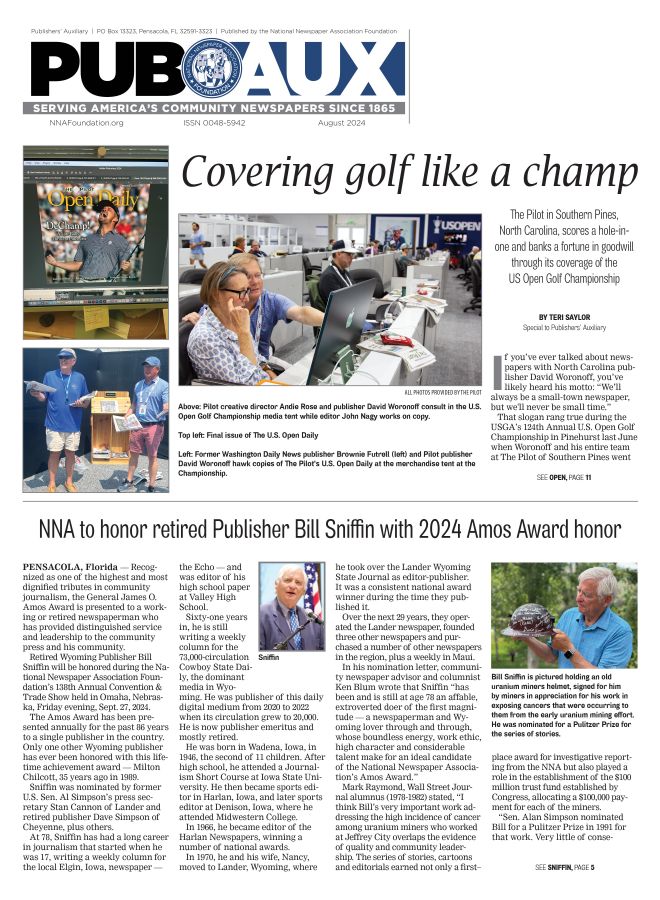If you produce good journalism, you can get direct contributions from readers
Al Cross
Sep 1, 2020



A new maxim — or is it a mandate? — of the newspaper business is “Get more revenue from your audience.” But that doesn’t have to come entirely in the form of higher subscription or single-copy prices; if you produce good journalism, you can get direct contributions from readers, and some community newspapers have proven it.
That was the big headline from “Success Stories in Rural Journalism,” a webinar the Institute for Rural Journalism and Community Issues held with four community editors on July 30. The frame for it was our belief that the two main solutions to challenges facing the news business are quality journalism and helping people understand what it is — distinguishing journalism from other kinds of information and helping people realize its value.
That’s why two of our webinar guests were from papers whose readers have demonstrated through donations that they know their papers’ value: John Gregg, news editor of the daily Valley News in West Lebanon, New Hampshire, and Laurie Ezzell Brown, editor and publisher of The Canadian Record, a weekly in the Texas Panhandle.
Direct reader support is helping the News thrive, and it’s helping the Record survive.
When the pandemic suppressed advertising and the Newspapers of New England chain decided to appeal for reader donations, the News set a goal of $50,000. “Within five days, we got that from about 600 contributors,” Gregg said. “By early June, we had raised $155,000 from about 1,500 people.” It made The Rural Blog at https://tinyurl.com/y2tuorvy.
Residents of the 40 Upper Connecticut River Valley towns covered by the Valley News clearly wanted to keep reading a first-class small daily. The paper emphasizes local news but also is part of the Granite State News Collaborative and uses material from VTDigger, a Vermont investigative newsroom.
Readers, who Gregg said “vary from fifth-generation dairy farmers to school bus drivers to heart surgeons,” surely appreciated the News’ comprehensive coverage of the pandemic, which Gregg discussed on the webinar and was exempted from the daily’s five-story paywall. “It was so clear that people were really dependent on us for news and were, you know, stuck at home, and all the more, we were their connection to the community.”
Coronavirus news made Brown publish more pages in her weekly than she probably should have, but people in Hemphill County are accustomed to extra effort from the Record, which has been in her family for 75 years. But the last three years have been hard, she said.
“We've survived crippling ice storms, devastating drought, deadly wildfires and tornadoes, and dramatic downturns in our two main industries, oil and gas and cattle ranching,” Brown said. “It doesn't even hold a candle to the impact of the virus has had on the small businesses that . . . had been our essential partners in the business of delivering the news to our readers.”
But two years ago, a seed was planted that has helped the paper survive. When a county commissioner said at a meeting, “Nobody reads the newspaper anymore,” Brown wrote an editorial explaining how wrong he was and inviting him to read the paper. “The response to that was pretty immediate and very emotional,” she recalled.
As the economy worsened, Brown was frank with her readers: “The Record is facing an uncertain financial future.” She said in the webinar, “I worry that we've written too much about the difficulty newspapers are facing today. I have never wanted to make us the story. But I realized at some point that it IS the story, that it’s one that’s crucial to our communities and that needs telling, and that what happens next will reshape the future of our communities.”
As the pandemic made Brown wonder if she could keep publishing, she got a letter from “a well-seasoned rancher” who “announced that he was writing $1,000 check to start a fund to help keep the Canadian Record going and invited others to do the same. This was completely unsolicited; it came out of the blue,” and more donations came. “The fund that Jerry established has been the thing that's kept us going for at least two months; we're not paying the bills any other way.”
Landmark Community Newspapers hasn’t asked for donations, but it has kept up its editorial quality, as Executive Editor John Nelson made clear with examples on the webinar, such as in-depth coverage of opioids by The Lancaster (South Carolina) News, Missouri River floods by the Opinion-Tribune of Glenwood, Iowa, and proposed “guardians” of schools by the Citrus County Chronicle in Florida.
The example from Nelson that really rang our bell, though, was a column by Editor-Publisher Ben Carlson of The Anderson News in Lawrenceburg, Kentucky, in Landmark’s company newsletter. It told how a man whose 14-year-old son had drowned refused to talk with TV reporters because “he did not want anyone to tell the story but the Anderson News.”
Carlson wrote that he shared the story “for those of you who feel beaten down by circulation struggles, revenue concerns and the constant drumbeat about how our industry is not only dying, it has become irrelevant. Nothing could be further from the truth. Yes. We'd like to sell more papers and advertising, but the value of our newspapers is more than the amount of money we deposit in the bank each week. To the communities we serve, we are where they come when things go right, but more importantly, when things go horribly wrong. They trust us because they know us, and that isn't something that any month in recap or spreadsheet can ever reflect.”
Nelson said, “I think I think Ben speaks for all of our committed rural editors.”
Jennifer P. Brown, editor-publisher of the Hoptown Chronicle, a digital startup in Hopkinsville, Kentucky, provided another example of how giving readers news they need and want can pay off.
When the pandemic hit, she converted the startup’s weekly newsletter (“almost like they were having a weekly paper delivered to them digitally”) into a daily coronavirus report, and her readership more than doubled. “Our coronavirus coverage really transformed Hoptown Chronicle and made many more readers aware of what we could do for them,” she said.
You can watch the webinar at https://tinyurl.com/y628bsdc. We hope to have more such webinars as we build a national community of rural journalists. If you have ideas for them, let us know.
Al Cross edited and managed rural newspapers before covering politics for the Louisville (Kentucky) Courier Journal and serving as president of the Society of Professional Journalists. He is director of the University of Kentucky’s Institute for Rural Journalism and Community Issues, which publishes The Rural Blog at http://irjci.blogspot.com. Cross will present the session Fighting Misinformation at NNA's 134th Annual Convention & Trade Show, to be held online, Oct. 1-3, 2020.










